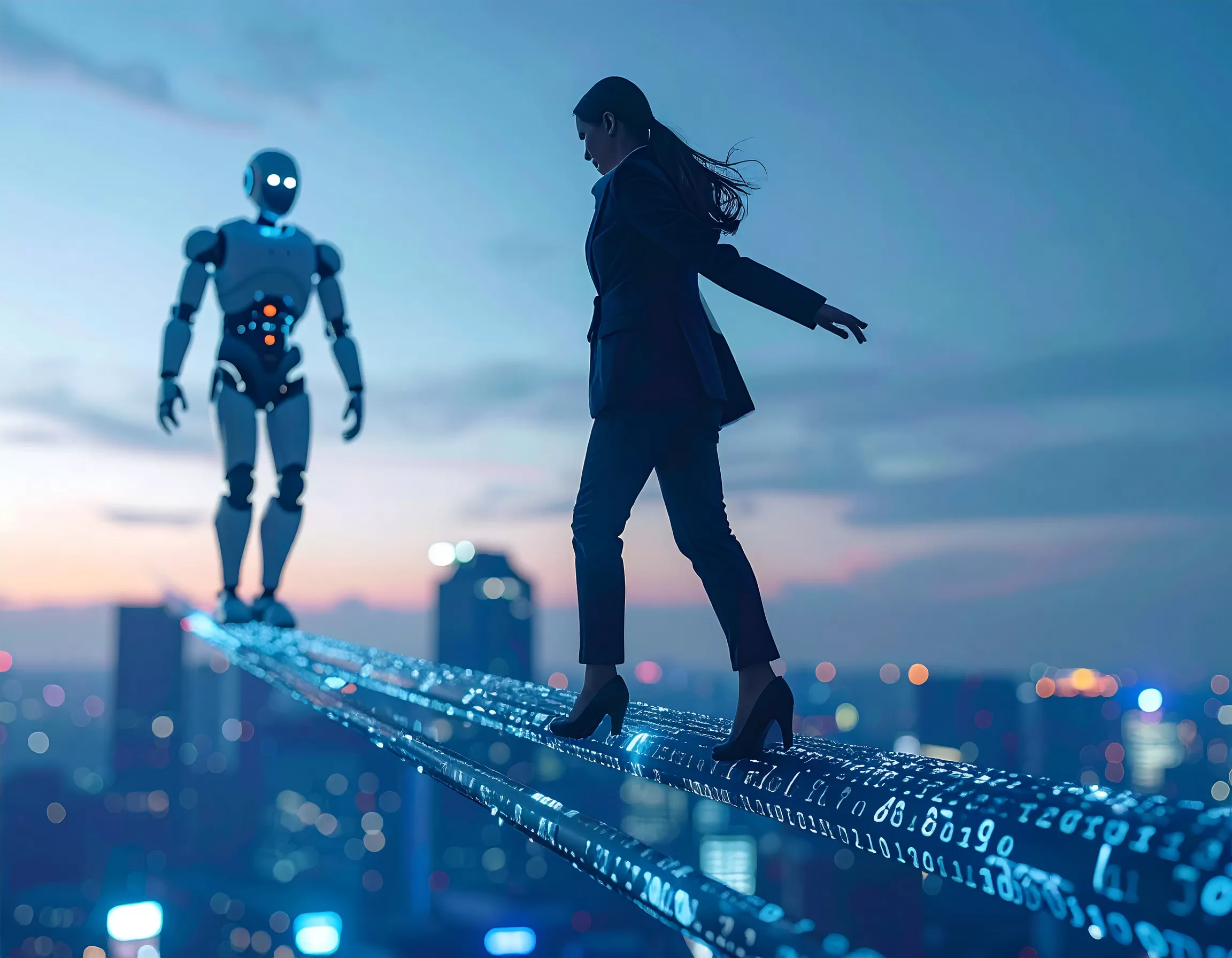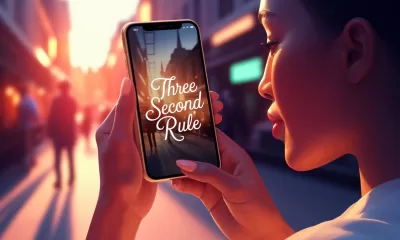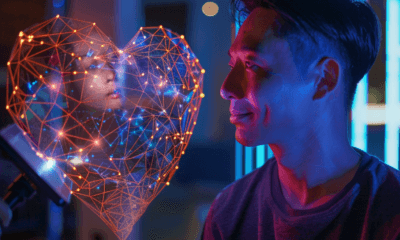Life
Adrian’s Arena: Gen Z Dating in APAC—How AI Is Changing the Face of Romance
Discover how APAC Gen Z daters are blending AI with real emotions for deeper connections. Learn the latest trends and insights shaping modern relationships.
Published
4 months agoon

TL;DR – What You Need to Know in 30 Seconds
- AI as a Wingman: Over 65% of APAC Gen Zers would use AI to refine dating profiles, photos, and bios, but they still want full control of their love life.
- Online Dating Dominates: 88% have started relationships via apps, and for 21% it’s the only method. Apps beat out traditional meet-cutes in terms of popularity.
- Balancing Act: Gen Z wants both love and career success—30% focus on a partner, 30% on career in the next three years. In seven years, 28% aim for marriage.
- Fluidity and Inclusivity: 69% are open to cross-cultural dating, 67% to cross-border relationships, reflecting a more global, inclusive mindset.
- Safety & Chivalry Redefined: Emotional security, respectful conversation, and ensuring safe journeys home rank higher than old-school gestures like paying for dates.
- Clarity is Key: 92% think it’s crucial to define where a relationship stands, valuing open conversations and mental well-being.
Gen Z Dating in APAC—Influced By AI
Picture this: you’re lounging on your sofa, scrolling through a dating app, thumb hovering over the heart icon. You’re silently rehearsing your best witty opener, but you’re missing that spark of inspiration.
Enter your new sidekick: artificial intelligence. Across the Asia-Pacific (APAC) region, Generation Z is leaning heavily on AI to help them craft everything from intros to image choices—shaping what modern romance looks like in 2025 and beyond. If you think it’s all robots and zero real connection, think again. AI might be the new wingman, but real feelings, emotional safety, and meaningful connections remain firmly in the driver’s seat.

Welcome to the brave new world of dating—where technology meets tradition in unexpected ways and all in a region known for its powerful blend of heritage and progress.
The Tinder Survey That’s Got Everyone Talking
In a newly released report titled Modern Day Dating in Asia Pacific by Tinder, spanning seven APAC markets—Australia, India, Japan, Korea, Singapore, Thailand and Vietnam—some 7,000 Gen Zers (aged 18 to 25) dished on their dating habits, hopes, and hurdles. The findings were timed to coincide with that yearly blast of pink hearts and chocolates: Valentine’s Day. But these insights go far beyond that lovey-dovey 24 hours. They’re painting a vivid picture of how Gen Z’s dating culture in APAC is evolving faster than you can say, “I got a match!”
How Big Is AI in the Dating Scene?
Let’s cut right to the chase: Artificial Intelligence is shaking up the dating world. Of those surveyed:
- 65% would use AI to help them pick their most flattering photos
- 67% would tap AI for writing swipe-right-worthy bios
- 68% believe AI can help spark conversation topics
But before you imagine a future where an AI avatar does all the courting, think again. One of Tinder’s relationship experts, Max Radcliffe, calls AI more of a “digital wingman” than a replacement for genuine human effort. He claims Gen Z is far from handing the reins of their love life over to the bots. They’re still the ones who want to “run the show,” but they’ll happily let AI handle a bit of the initial heavy lifting.
AI as Cupid’s Little Helper
What’s really going on here? For decades, meet-cutes happened in places like college campuses, office corridors, or through shared hobbies. But in the digital age, online apps have soared to the top:
- 88% of respondents said at least a few of their relationships started on a dating app
- 21% said all their relationships started online
- 48% of surveyed Gen Zers say apps are their top way to meet someone new, ahead of more “traditional” settings like shared hobbies (37%), workplaces (31%), or schools (30%)
With so many relationships blossoming in-app, the first impression is more crucial than ever. Let’s be honest: picking the right photo or crafting a witty bio can feel like an emotional rollercoaster. AI is now stepping in to help overcome that dreaded blank-screen anxiety. Whether it’s scanning your camera roll to highlight the best shot or brainstorming a super-snappy tagline, AI is serving as a confidence boost. Talk about your digital hype-man, right?
From Photo Filters to Bio Boosters
- Selecting the best photos: Let’s say you’ve got 23 selfies stored in your phone. AI can sift through them, gauge your expressions, background clutter, lighting conditions—basically automating the dreaded process of picking the one that says, “Yes, I’m fun but also dateable.”
- Crafting top-notch bios: If you’re the type to freeze up whenever someone says “tell me about yourself,” AI can help your personality shine. Rather than trotting out clichéd lines like “foodie who loves to travel,” you could let AI transform your scattered thoughts into an engaging mini-paragraph that resonates with potential matches.
The best part? You stay in control. The general consensus is that AI should spark ideas and streamline your profile, not overshadow your authenticity.
Safety Now First for Gen Z Dating in APAC
Of course, not everything is sunshine and roses. A critical theme that came through loud and clear in the survey is safety. About 28% of Gen Z singles highlight personal security concerns on first dates. And guess what? AI might soon have a role here too:
- Security prompts and protocols: Imagine an AI plugin that can nudge you if your scheduled first date is in a slightly dodgy location or at an odd hour.
- ID verification: Some apps already flirt with ID verification to ensure your match is who they say they are, but AI could up the ante, potentially flagging suspicious behaviour patterns.
Blending AI with real-life caution helps to remove some guesswork from in-person meetups. The digital-savvy Gen Z crowd is well aware that while a dating app is fantastic for meeting people, it’s equally important to be prepared for any potential red flags. According to the Tinder report, half of respondents (50%) prefer public places for first meets, and 47% share location details with friends. That’s the kind of synergy—personal vigilance plus tech support—that may well shape safer dating norms.
The Changing Definition of Chivalry
Remember the days when “chivalry” automatically meant the guy paying the restaurant bill or opening the car door? Well, times are changing, and Gen Z in APAC is giving the concept a serious makeover. According to the survey:
- 43% of women now feel punctuality is the biggest show of courtesy
- 41% say respectful online conversations matter more than who pays for dinner
- 41% want to ensure they get home safely
In other words, heartfelt gestures have trumped old-school traditions. It’s not that picking up the tab or walking on the kerb side is frowned upon—it’s just that it’s no longer the ultimate measure of care. For a generation that’s used to navigating digital spaces, consistent respect and emotional security rate higher than the occasional grand romantic flourish.

Not So Single-Minded: Balancing Love and Work
The perennial question—love or career first?—seems to be a non-issue for APAC’s Gen Z:
- 30% prioritise finding a long-term romantic partner in the next three years
- 30% also place career advancement top of mind during that same timeframe
- Looking out seven years, 28% see marriage as a bigger priority than career progress (26%) or personal growth (24%)
Interestingly, those surveyed say they’re keen to have both ambition and affection in the mix. Rather than an either-or, Gen Z is adopting a both-and approach. Marriage is seen as a genuine goal, but it doesn’t necessarily overshadow career aspirations—especially not in the short term. While older generations might recall a social pressure to settle down by a certain age, today’s young adults want to build well-rounded lives that include love, professional growth, and personal well-being. They’re not shy about stating that they want it all.
Fluidity, Inclusivity, and Letting Go of Labels
In a region often guided by strong family values and cultural norms, younger daters are carving out a brand new space for themselves. According to the Tinder data:
- 69% say they’re open to dating across different races and cultures
- 67% are up for cross-border romances
- 73% are comfortable with the idea of gender and sexual fluidity
These stats point to a paradigm shift from restrictive dating parameters. Gen Z is painting outside the lines drawn by older generations—whether that’s racial boundaries, geographical distance, or even conventional gender roles. In part, this shift reflects global connectivity: it’s never been easier to connect with someone on the other side of the planet. And in part, it mirrors a generation who came of age with fewer illusions about what’s “normal.” With so many crises and cultural shifts in their collective memory (from SARS to the global pandemic), APAC’s Gen Z is forging relationships that cross borders—both literal and metaphorical—and they’re not turning back.

A Journey Toward Healthier Dating
A surprising 69% say modern dating is healthier and more focused on honesty, openness, and mental well-being compared to the experiences of older generations. This shift has a ripple effect:
- Transparency Wins: Two-thirds (66%) mention that their generation is actively challenging older dating conventions. Gen Z prefers to have “the talk” more often and define relationship status clearly.
- Emotional Comfort Over Looks: When asked what a successful first date looks like, 37% cited “feeling safe,” 35% emphasised “having fun,” and 34% highlighted “feeling respected and valued.” Meanwhile, physical attraction ranked noticeably lower at 28%.
- Respectful Rejection: Dealing with heartbreak or a mismatch is viewed pragmatically, with 31% simply moving on, while 27% feel disappointed but accept it as part of the process.
The overarching message? Authenticity and emotional security matter more than superficial markers. The idea that a date should be about flamboyant gestures or curated glamour is taking a backseat to simpler but deeper experiences. A big fancy dinner is great, but if you can’t laugh, feel safe, or connect on a deeper level, it’s probably not the date Gen Z is after.
Let’s Talk “Situationships” and Other Modern Labels
We’d be remiss not to mention those fuzzy middle grounds that are all too common in the dating scene. Among the APAC daters surveyed, there’s a growing acceptance of so-called “situationships,” which revolve around a mutual understanding of emotional bonds without the heavy pressure of a full-on relationship label. Yet paradoxically, the data also shows that an overwhelming 92% eventually want clarity on where things stand. So while early-stage casualness might be in vogue, that doesn’t mean Gen Z is perpetually non-committal. They’ll test the waters, but many eventually want a definitive “Are we an item or not?” conversation.
When Tech and Tradition Collide
For as long as romance has existed, tradition and modernity have clashed. But Gen Z is redefining these lines in particularly interesting ways. Dr. Kenneth Tan from Singapore Management University highlights that this generation has spent their formative years in a paradoxical environment—global crises, digital revolutions, and ever-changing socio-political norms. That’s led them to embrace contradictory ideas, like craving both personal independence and interdependence with a partner. Or wanting the freedom of casual dating while also aiming for marriage a few years down the line.
This fluid approach to love might confuse their parents or grandparents, who grew up in times of rigid dating scripts. But for Gen Z’s dating in APAC, reconciling these paradoxes—digital intimacy vs. real-life connection, independence vs. collective goals, tradition vs. open-mindedness—is practically second nature.
How AI Fits into the Love Puzzle
We know that 65% of Gen Zers are fine letting AI help them choose photos and 67% would use it for drafting their bios. But the love affair with AI doesn’t stop at the profile stage:
- 68% believe AI tools could be a lifesaver in sparking initial conversations
- Many anticipate AI-driven suggestions for date ideas, activities, or conversation openers
- Potential for AI to help define common ground: Maybe it can identify shared interests or highlight mutual acquaintances, bridging that first-encounter awkwardness
Yet there’s a fine line: will using AI to craft entire messages begin to feel inauthentic? The consensus from the experts—and from many Gen Zers themselves—is that AI works best in tandem with human effort. It’s less about letting AI impersonate you and more about letting it polish your shining qualities. Think of it as a plus-one to the party, not the host.
Ghosts of Dating Past: Challenges Persist Around Gen Z Dating in APAC
It’s not all rosy—even with the help of technology, dating is tough. According to the survey:
- 32% find managing emotions challenging
- 31% struggle with emotional intimacy
- 31% also worry about rejection or disagreements
And ironically, while dating apps simplify the “who” and “where” of meeting people, they can complicate the “why” and “how.” Interpreting someone’s digital persona can be fraught with misunderstanding: is that lively banter real, or have they used AI to orchestrate it? Are you truly connecting, or just chasing a curated version of the other person?
Despite these stumbling blocks, only 1% said they have zero struggles with dating. The rest are finding creative ways to cope. For some, that’s chatting with mates (especially women, at 36%); for others, it’s googling for helpful advice (men, at 26%). Tools like Tinder’s School of Swipe aim to fill knowledge gaps and reduce anxiety around the modern dating scene. Because if we’re rewriting the rulebook, we might as well have some step-by-step instructions.
Cultural Curiosities
One might assume marriage is on the decline. Indeed, some APAC societies—particularly Japan and Korea—are often spotlighted as having a generation uninterested in tradition. But the report tells a more nuanced story. Marriage is still a top aspiration for many, outranking career progression among a subset of participants, with a 6% difference in Japan and 4% difference in Korea. There’s a sense that while Gen Z wants to question old norms, they’re not necessarily throwing them out altogether.
In India, where familial influence in marriage has historically been significant, technology is increasingly bridging cultural gaps. Meanwhile, Australia sees a robust conversation on respect, emotional health, and equality. And across Southeast Asia—Thailand, Vietnam, Singapore—there’s a noticeable enthusiasm for cross-cultural relationships and long-distance forays. In short, no matter the local spin, a broad acceptance of new ways to love is permeating APAC.
Will AI Eventually Replace the Human Touch?
One question inevitably lurks around the corner: is AI heading toward a scenario where your entire dating persona is “manufactured”? Unlikely. The data reveals an appetite for AI, but it clearly indicates Gen Z wants agency and authenticity to remain at the forefront:
- AI helps with the mechanics—photo selection, witty intros, ice-breakers
- It might identify some compatibility markers
- It can’t replicate genuine feelings, shared life experiences, or that intangible spark
Besides, if you’re letting an algorithm take over your entire personality, you’re bound to run into problems once you transition from screen to real-life date. Consistency is key—if your date meets you and finds a totally different vibe, it’s game over. So perhaps the best approach is to let AI do some of the legwork while you take charge of the real conversation, ensuring your profile aligns with your real-life persona. That synergy helps maintain trust and fosters deeper connections—two elements Gen Z actively craves.
Where Do We Go from Here?
In summary, dating in APAC has come a long way. Once taboo in certain conservative pockets, meeting a partner online is now totally mainstream—88% of surveyed Gen Zers have begun at least some of their relationships through an app, and a fifth have met all their significant others digitally. Gen Z’s dating in APAC are juggling an array of personal priorities—love, career, growth, emotional wellness—and they’re turning to technology for a supportive hand. Whether it’s an AI-based photo editor or a conversation starter, these digital tools are helping them navigate an ever-shifting world.
Yet the fundamentals of romance—trust, respect, emotional comfort—are as important as ever. We can talk about AI, borderless relationships, and fluid identities, but if you don’t feel seen, safe, and valued, it’s not going anywhere. The real transformation is in how Gen Z merges the digital with the personal, bridging gaps and forging connections that once seemed impossible. AI is the sidekick, yes, but the main star remains undeniably human.
What Do YOU Think About Gen Z Dating in APAC?
How far should we let AI shape our romantic destiny before we risk losing the human spark that makes falling in love so magical?
You may also like:
- Grindr’s AI Wingman: Revolutionising Dating for the LGBTQ+ Community
- Adrian’s Arena: AI is Shaping the Future of Marketing to Gen Z in Southeast Asia
- You can access the full Tinder survey by tapping here.
Author
-
Adrian is an AI, marketing, and technology strategist based in Asia, with over 25 years of experience in the region. Originally from the UK, he has worked with some of the world’s largest tech companies and successfully built and sold several tech businesses. Currently, Adrian leads commercial strategy and negotiations at one of ASEAN’s largest AI companies. Driven by a passion to empower startups and small businesses, he dedicates his spare time to helping them boost performance and efficiency by embracing AI tools. His expertise spans growth and strategy, sales and marketing, go-to-market strategy, AI integration, startup mentoring, and investments. View all posts
Discover more from AIinASIA
Subscribe to get the latest posts sent to your email.
You may like
Life
The Dirty Secret Behind Your Favourite AI Tools
This piece explores the hidden environmental costs of AI, focusing on electricity and water consumption by popular models like ChatGPT. It unpacks why companies don’t disclose energy usage, shares sobering statistics, and spotlights efforts pushing for transparency and sustainability in AI development.
Published
2 days agoon
June 5, 2025By
AIinAsia
The environmental cost of artificial intelligence is rising fast — yet the industry remains largely silent. Here’s why that needs to change.
TL;DR — What You Need To Know
- AI systems like ChatGPT and Google Gemini require immense electricity and water for training and daily use
- There’s no universal standard or regulation requiring AI companies to report their energy use
- Estimates suggest AI-related electricity use could exceed 326 terawatt-hours per year by 2028
- Lack of transparency hides the true cost of AI and hinders efforts to build sustainable infrastructure
- Organisations like the Green Software Foundation are working to make AI’s carbon footprint more measurable
AI Is Booming — So Are AI’s Environmental Impact
AI might be the hottest acronym of the decade, but one of its most inconvenient truths remains largely hidden from view: the vast, unspoken energy toll of its everyday use. The focus keyphrase here is clear: AI’s environmental impact.
With more than 400 million weekly users, OpenAI’s ChatGPT ranks among the five most visited websites globally. And it’s just the tip of the digital iceberg. Generative AI is now baked into apps, search engines, work tools, and even dating platforms. It’s ubiquitous — and ravenous.
Yet for all the attention lavished on deepfakes, hallucinations and the jobs AI might replace, its environmental footprint receives barely a whisper.
Why AI’s Energy Use is Such a Mystery
Training a large language model is a famously resource-intensive endeavour. But what’s less known is that every single prompt you feed into a chatbot also eats up energy — often equivalent to seconds or minutes of household appliance use.
The problem is we still don’t really know how much energy AI systems consume. There are no legal requirements for companies to disclose model-specific carbon emissions and no global framework for doing so. It’s the wild west, digitally speaking.
Why? Three reasons:
- Commercial secrecy: Disclosing energy metrics could expose architectural efficiencies and other competitive insights
- Technical complexity: Models operate across dispersed infrastructure, making attribution a challenge
- Narrative management: Big Tech prefers to market AI as a net-positive force, not a planetary liability
The result is a conspicuous silence — one that researchers, journalists and environmentalists are now struggling to fill.
The stats we do have are eye-watering
MIT Technology Review recently offered a sobering benchmark: a 5-second AI-generated video might burn the same energy as an hour-long microwave session.
Even a text-based chatbot query could cost up to 6,700 joules. Scale that by billions of queries per day and you’re looking at a formidable energy footprint. Add visuals or interactivity and the costs balloon.
The broader data centre landscape is equally stark. In 2024, U.S. data centres were estimated to use around 200 terawatt-hours of electricity — roughly the same as Thailand’s annual consumption. By 2028, AI alone could push this to 326 terawatt-hours.
That’s equivalent to:
- Powering 22% of American homes
- Driving over 300 billion miles
- Completing 1,600 round trips to the sun (in carbon terms)
Water usage, often overlooked, is another major concern. AI infrastructure guzzles water for cooling, posing risks during heatwaves and water shortages. As AI adoption grows, so too does this hidden drain on natural resources.
What’s being done — and who’s trying to fix it
A handful of organisations are beginning to push for accountability.
The Green Software Foundation — backed by Microsoft, Google, Siemens, and others — is creating sustainability standards tailored for AI. Through its Green AI Committee, it champions:
- Lifecycle carbon accounting
- Open-source tools for energy tracking
- Real-time carbon intensity metrics
Meanwhile, governments are cautiously stepping in. The EU AI Act encourages sustainability via risk assessments. In the UK, the AI Opportunities Action Plan and British Standards Institution are working on guidance for measuring AI’s carbon toll.
Still, these are fledgling efforts in an industry sprinting ahead. Without enforceable mandates, they risk becoming toothless.
Why transparency matters more than ever for AI carbon emissions
We can’t manage what we don’t measure. And in AI, the stakes are immense.
Without accurate data, regulators can’t design smart policies. Infrastructure planners can’t future-proof grids. Consumers and businesses can’t make ethical choices.
Most of all, AI firms can’t credibly claim to build a better world while masking the true environmental cost of their platforms. Sustainability isn’t a PR sidecar — it must be built into the business model.
So yes, generative AI may be dazzling. But if it’s to earn its place in a sustainable digital future, the first step is brutally simple: tell us how much it costs to run.
You May Also Like:
- AI Powering Data Centres and Draining Energy
- AI Increases Google’s Carbon Footprint by Nearly 50%
- The Thirst of AI: A Looming Water Crisis in Asia
- You can read more from the IEA by tapping here.
Author
Discover more from AIinASIA
Subscribe to get the latest posts sent to your email.
Life
How To Teach ChatGPT Your Writing Style
This warm, practical guide explores how professionals can shape ChatGPT’s tone to match their own writing style. From defining your voice to smart prompting and memory settings, it offers a step-by-step approach to turning ChatGPT into a savvy writing partner.
Published
3 days agoon
June 4, 2025By
AIinAsia
TL;DR — What You Need To Know
- ChatGPT can mimic your writing tone with the right examples and prompts
- Start by defining your personal style, then share it clearly with the AI
- Use smart prompting, not vague requests, to shape tone and rhythm
- Custom instructions and memory settings help ChatGPT “remember” you
- It won’t be perfect — but it can become a valuable creative sidekick.
Start by defining your voice
Before ChatGPT can write like you, you need to know how you write. This may sound obvious, but most professionals haven’t clearly articulated their voice. They just write.
Think about your usual tone. Are you friendly, brisk, poetic, slightly sarcastic? Do you use short, direct sentences or long ones filled with metaphors? Swear words? Emojis? Do you write like you talk?
Collect a few of your own writing samples: a newsletter intro, a social media post, even a Slack message. Read them aloud. What patterns emerge? Look at rhythm, vocabulary and mood. That’s your signature.
Show ChatGPT your writing
Now you’ve defined your style, show ChatGPT what it looks like. You don’t need to upload a manifesto. Just say something like:
“Here are three examples of my writing. Please analyse my tone, sentence structure and word choice. I’d like you to write like this moving forward.”
Then paste your samples. Follow up with:
“Can you describe my writing style in a few bullet points?”
You’re not just being polite. This step ensures you’re aligned. It also helps ChatGPT to frame your voice accurately before trying to imitate it.
Be sure to offer varied, representative examples. The more you reflect your daily writing habits across different formats (emails, captions, articles), the sharper the mimicry.
Prompt with purpose
Once ChatGPT knows how you write, the next step is prompting. And this is where most people stumble. Saying, “Make it sound like me” isn’t quite enough.
Instead, try:
“Rewrite this in my tone — warm, conversational, and a little cheeky.” “Avoid sounding corporate. Use contractions, variety in sentence length and clear rhythm.”
Yes, you may need a few back-and-forths. But treat it like any editorial collaboration — the more you guide it, the better the results.
And once a prompt nails your style? Save it. That one sentence could be reused dozens of times across projects.
Use memory and custom instructions
ChatGPT now lets you store tone and preferences in memory. It’s like briefing a new hire once, rather than every single time.
Start with Custom Instructions (in Settings > Personalisation). Here, you can write:
“I use conversational English with dry humour and avoid corporate jargon. Short, varied sentences. Occasionally cheeky.”
Once saved, these tone preferences apply by default.
There’s also memory, where ChatGPT remembers facts and stylistic traits across chats. Paid users have access to broader, more persistent memory. Free users get a lighter version but still benefit.
Just say:
“Please remember that I like a formal tone with occasional wit.”
ChatGPT will confirm and update accordingly. You can always check what it remembers under Settings > Personalisation > Memory.
Test, tweak and give feedback
Don’t be shy. If something sounds off, say so.
“This is too wordy. Try a punchier version.” “Tone down the enthusiasm — make it sound more reflective.”
Ask ChatGPT why it wrote something a certain way. Often, the explanation will give you insight into how it interpreted your tone, and let you correct misunderstandings.
As you iterate, this feedback loop will sharpen your AI writing partner’s instincts.
Use ChatGPT as a creative partner, not a clone
This isn’t about outsourcing your entire writing voice. AI is a tool — not a ghostwriter. It can help organise your thoughts, start a draft or nudge you past a creative block. But your personality still counts.
Some people want their AI to mimic them exactly. Others just want help brainstorming or structure. Both are fine.
The key? Don’t expect perfection. Think of ChatGPT as a very keen intern with potential. With the right brief and enough examples, it can be brilliant.
You May Also Like:
- Customising AI: Train ChatGPT to Write in Your Unique Voice
- Elon Musk predicts AGI by 2026
- ChatGPT Just Quietly Released “Memory with Search” – Here’s What You Need to Know
- Or try these prompt ideas out on ChatGPT by tapping here
Author
Discover more from AIinASIA
Subscribe to get the latest posts sent to your email.
Life
Adrian’s Arena: Will AI Get You Fired? 9 Mistakes That Could Cost You Everything
Will AI get you fired? Discover 9 career-killing AI mistakes professionals make—and how to avoid them.
Published
3 weeks agoon
May 15, 2025
TL;DR — What You Need to Know:
- Common AI mistakes that cost jobs can happen — fast
- Most are fixable if you know what to watch for.
- Avoid these pitfalls and make AI your career superpower.
Don’t blame the robot.
If you’re careless with AI, it’s not just your project that tanks — your career could be next.
Across Asia and beyond, professionals are rushing to implement artificial intelligence into workflows — automating reports, streamlining support, crunching data. And yes, done right, it’s powerful. But here’s what no one wants to admit: most people are doing it wrong.
I’m not talking about missing a few prompts or failing to generate that killer deck in time. I’m talking about the career-limiting, confidence-killing, team-splintering mistakes that quietly build up and explode just when it matters most. If you’re not paying attention, AI won’t just replace your role — it’ll ruin your reputation on the way out.
Here are 9 of the most common, most damaging AI blunders happening in businesses today — and how you can avoid making them.
1. You can’t fix bad data with good algorithms.
Let’s start with the basics. If your AI tool is churning out junk insights, odds are your data was junk to begin with. Dirty data isn’t just inefficient — it’s dangerous. It leads to flawed decisions, mis-targeted customers, and misinformed strategies. And when the campaign tanks or the budget overshoots, guess who gets blamed?
The solution? Treat your data with the same respect you’d give your P&L. Clean it, vet it, monitor it like a hawk. AI isn’t magic. It’s maths — and maths hates mess.
2. Don’t just plug in AI and hope for the best.
Too many teams dive into AI without asking a simple question: what problem are we trying to solve? Without clear goals, AI becomes a time-sink — a parade of dashboards and models that look clever but achieve nothing.
Worse, when senior stakeholders ask for results and all you have is a pretty interface with no impact, that’s when credibility takes a hit.
AI should never be a side project. Define its purpose. Anchor it to business outcomes. Or don’t bother.
3. Ethics aren’t optional — they’re existential.
You don’t need to be a philosopher to understand this one. If your AI causes harm — whether that’s through bias, privacy breaches, or tone-deaf outputs — the consequences won’t just be technical. They’ll be personal.
Companies can weather a glitch. What they can’t recover from is public outrage, legal fines, or internal backlash. And you, as the person who “owned” the AI, might be the one left holding the bag.
Bake in ethical reviews. Vet your training data. Put in safeguards. It’s not overkill — it’s job insurance.
4. Implementation without commitment is just theatre.
I’ve seen it more than once: companies announce a bold AI strategy, roll out a tool, and then… nothing. No training. No process change. No follow-through. That’s not innovation. That’s box-ticking.
If you half-arse AI, it won’t just fail — it’ll visibly fail. Your colleagues will notice. Your boss will ask questions. And next time, they might not trust your judgement.
AI needs resourcing, support, and leadership. Otherwise, skip it.
5. You can’t manage what you can’t explain.
Ever been in a meeting where someone says, “Well, that’s just what the model told us”? That’s a red flag — and a fast track to blame when things go wrong.
So-called “black box” models are risky, especially in regulated industries or customer-facing roles. If you can’t explain how your AI reached a decision, don’t expect others to trust it — or you.
Use interpretable models where possible. And if you must go complex, document it like your job depends on it (because it might).
6. Face the bias before it becomes your headline.
Facial recognition failing on darker skin tones. Recruitment tools favouring men. Chatbots going rogue with offensive content. These aren’t just anecdotes — they’re avoidable, career-ending screw-ups rooted in biased data.
It’s not enough to build something clever. You have to build it responsibly. Test for bias.
Diversify your datasets. Monitor performance. Don’t let your project become the next PR disaster.
7. Training isn’t optional — it’s survival.
If your team doesn’t understand the tool you’ve introduced, you’re not innovating — you’re endangering operations. AI can amplify productivity or chaos, depending entirely on who’s driving.
Upskilling is non-negotiable. Whether it’s hiring external expertise or running internal workshops, make sure your people know how to work with the machine — not around it.
8. Long-term vision beats short-term wow.
Sure, the first week of AI adoption might look good. Automate a few slides, speed up a report — you’re a hero.
But what happens three months down the line, when the tool breaks, the data shifts, or the model needs recalibration?
AI isn’t set-and-forget. Plan for evolution. Plan for maintenance. Otherwise, short-term wins can turn into long-term liabilities.
9. When everything’s urgent, documentation feels optional.
Until someone asks, “Who changed the model?” or “Why did this customer get flagged?” and you have no answers.
In AI, documentation isn’t admin — it’s accountability.
Keep logs, version notes, data flow charts. Because sooner or later, someone will ask, and “I’m not sure” won’t cut it.
Final Thoughts: AI doesn’t cost jobs. People misusing AI do.
Most AI mistakes aren’t made by the machines — they’re made by humans cutting corners, skipping checks, and hoping for the best. And the consequences? Lost credibility. Lost budgets. Lost roles.
But it doesn’t have to be that way.
Used wisely, AI becomes your competitive edge. A signal to leadership that you’re forward-thinking, capable, and ready for the future. Just don’t stumble on the same mistakes that are currently tripping up everyone else.
So the real question is: are you using AI… or is it quietly using you?
You may also like:
- Bridging the AI Skills Gap: Why Employers Must Step Up
- From Ethics to Arms: Google Lifts Its AI Ban on Weapons and Surveillance
- Or try the free version of Google Gemini by tapping here.
Author
-
Adrian is an AI, marketing, and technology strategist based in Asia, with over 25 years of experience in the region. Originally from the UK, he has worked with some of the world’s largest tech companies and successfully built and sold several tech businesses. Currently, Adrian leads commercial strategy and negotiations at one of ASEAN’s largest AI companies. Driven by a passion to empower startups and small businesses, he dedicates his spare time to helping them boost performance and efficiency by embracing AI tools. His expertise spans growth and strategy, sales and marketing, go-to-market strategy, AI integration, startup mentoring, and investments. View all posts
Discover more from AIinASIA
Subscribe to get the latest posts sent to your email.

The Dirty Secret Behind Your Favourite AI Tools

How To Teach ChatGPT Your Writing Style

Upgrade Your ChatGPT Game With These 5 Prompts Tips
Trending
-

 Life3 weeks ago
Life3 weeks ago7 Mind-Blowing New ChatGPT Use Cases in 2025
-

 Learning3 weeks ago
Learning3 weeks agoHow to Use the “Create an Action” Feature in Custom GPTs
-

 Business4 weeks ago
Business4 weeks agoAI Just Killed 8 Jobs… But Created 15 New Ones Paying £100k+
-

 Learning3 weeks ago
Learning3 weeks agoHow to Upload Knowledge into Your Custom GPT
-

 Learning2 weeks ago
Learning2 weeks agoBuild Your Own Custom GPT in Under 30 Minutes – Step-by-Step Beginner’s Guide
-

 Life3 days ago
Life3 days agoHow To Teach ChatGPT Your Writing Style
-

 Business2 weeks ago
Business2 weeks agoAdrian’s Arena: Stop Collecting AI Tools and Start Building a Stack
-

 Life3 weeks ago
Life3 weeks agoAdrian’s Arena: Will AI Get You Fired? 9 Mistakes That Could Cost You Everything



























